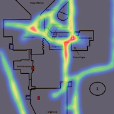Principles of cognitive psychology applied to mobility problems in urban space Intervention in Clínica Las Condes
Main Article Content
Abstract
This study is part of an intervention performed at Clinica Las Condes in Santiago, financed by such institution. The research and execution were conducted by the behavioral consultant Recursos Limbicos.
Article Details
References
Allen, G. L. (2006) Applied spatial cognition. Mahwah, NJ: Lawrence Erlbaum.
Awh, E., Barton B., and Vogel E.K. (2007) Visual working memory represents a fixed number of items regardless of complexity. Psychological science 18; 7, 622-628.
De Castro, C. Mapas cognitivos (1999) Qué son y cómo explorarlos. Scripta Nova: revista electrónica de geografía y ciencias sociales 5.
Golledge, R. G. (1999) Human wayfinding and cognitive maps. en Wayfinding behavior: Cognitive mapping and other spatial processes. 5-45, JHU Press.
Hart, R.A.; Moore, G.T. (1978) The development of spatial cognition: A Review. En Downs R.M. y Stea D. (Eds). Image and environment cognitive mapping and spatial behavior. Ed. Aldine, Chicago.
Hidalgo, R., Borsdorf A., y Sánchez R. (2007 ) Hacia un nuevo tejido rurbano: los megaproyectos de ciudades valladas en la periferia de Santiago de Chile. Ciudad y Territorio-Estudios Territoriales 151; 115.
Kahneman, D. (2011) Thinking fast and Slow. Ed. FSG. New York.
Lynch, K. (1960) La Imagen de la Ciudad, Boston.
Nobre, A. C., Coull J. T., Maquet P., Frith C. D., Vandenberghe R., and Mesulam M. M. (2004) “Orienting attention to locations in perceptual versus mental representations.” Journal of Cognitive Neuroscience 16; 3, 363-373.
Migueles, M. y García. E. (1993) Mapas Cognitivos al interior de un edificio conocido. Revista de Psicología general y aplicada, 46 (4), 379-386. Universidad del País Vasco, España.
Miller, G. (1956) The magical number seven, plus or minus two: Some limits on our capacity for processing information. Psychological Review.


